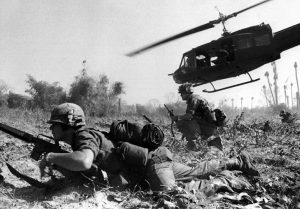On Veterans Day, learn about the Battle of Ia Drang at Richland Library
October 30, 2024The battle of Ia Drang in 1965 was the first great clash between the U.S. and North Vietnamese armies. About 237 Americans were killed, along with 132 South Vietnamese, and many more NVA soldiers. The clash was immortalized in the film, “We Were Soldiers.”
Five South Carolinians died in that battle, which set the stage for the very new kind of warfare in which American would engage over the succeeding years – with soldiers whisked to the battleground by helicopter. One of those who died, Sgt. Earthell Tyler, was born here in Columbia, and is buried here.
There is no better time than Veterans Day to learn more about what those men did during those days of continuous fighting from Nov. 14-18, 1965. That is the intent of a free lecture that Fritz Hamer, former curator of history at the South Carolina Confederate Relic Room and Military Museum, will present at 1 p.m. on Monday, Nov. 11, in the Theater of the main Richland Library location on Assembly Street in Columbia.
This battle “kind of set the tone for the rest of American involvement” in Vietnam, says Hamer. Gen. William Westmoreland (another South Carolinian) saw it as victory because 2,000 NVA were killed. And the initial estimate was more like 10,000 – which was far more than the number present. That exaggerated “body count” perspective would predominate almost entirely through the war – or the American portion of it.
The enemy drew the opposite conclusion. After sending their regiments into battle against the high-tech, far-better-equipped U.S. Army, “The North learned they could fight superior firepower and survive,” Hamer said. That meant they could “Win a war of attrition, even losing more people.”
Hamer will talk about the history of the fabled Seventh Cavalry, and about Lt. Col. Hal Moore, who led that unit’s 1st Battalion into the battle. Moore, a 1945 West Point grad and one of the best known and honored officers of the war, would eventually be portrayed by Mel Gibson on the big screen – but there are many interesting things to know about him beyond that.
The Army had been working on this transition of Custer’s old horsemen into a new kind of airmobile soldier since the late 1950s. Moore had a significant hand in developing the training, and he would be the first to lead men into a fight that tested the concept.
He and his men left Fort Benning – now Fort Moore – to board a ship in Charleston in August 1965 and sail all the way to Vietnam.
After they got there the Army received intelligence that North Vietnamese troops were in this area, near the border with Cambodia. But the Americans had no idea there were three regiments of them – men who had trained in the North, and taken two months to hike down the Ho Chi Minh Trail to enter the Central Highlands and confront the new American enemy in direct, open battle. There were 2,500 of them.
There were 1,000 American 7th Cavalry troopers, and 900 South Vietnamese soldiers with them – along with helicopter and fixed-wing pilots and crews, plus artillery units. That’s according to Wikipedia. Hamer says the effective force under Moore – whose battalion was supposed to have 700-800 – was only at about 450 at the start of the battle.
Of those, 151 would die.
This program is one of many live programs presented regularly at the Relic Room, which is about to reopen after being closed to general admission for several months for renovation and reorganization of artifacts. Richland Library has lent the museum its beautiful theater for several live programs during the closure, and this will be the latest.
About the South Carolina Confederate Relic Room and Military Museum
Founded in 1896, the South Carolina Confederate Relic Room and Military Museum is an accredited museum focusing on South Carolina’s distinguished martial tradition through the Revolutionary War, Mexican War, Civil War, Spanish-American War, World Wars I and II, Vietnam, the War on Terror, and other American conflicts. It serves as the state’s military history museum by collecting, preserving, and exhibiting South Carolina’s military heritage from the colonial era to the present, and by providing superior educational experiences and programming. It recently opened a major new exhibit, “A War With No Front Lines: South Carolina and the Vietnam War, 1965-1973.” The museum is located at 301 Gervais St. in Columbia, sharing the Columbia Mills building with the State Museum. For more information, go to https://crr.sc.gov/.

















